When starting a vegetable garden, no matter what the soil, do not pick up a shovel before you have outlined a plan for placing vegetable crops in your garden. It is also necessary to know the composition of the soil for proper cultivation of the soil for garden plants.
Proper garden planning
Rice. 1. Garden plan
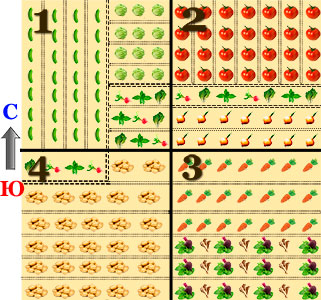 Divide the part of the garden planned for vegetables into four plots: on the first plot, place the crops that require large quantity organic fertilizers - cucumbers and cabbage, on the second - tomatoes and onions, on the third (after adding mineral fertilizers) - root vegetables, and carrots should be placed next to the onions of the second plot, since these crops will mutually protect from flies: onions protect carrots from carrots flies, and protect the carrots from the onion fly. And in the fourth plot place early potatoes. Beware of growing potatoes next to tomatoes or after tomatoes, and tomatoes after potatoes, as both crops are affected by the same fungus - late blight.
Divide the part of the garden planned for vegetables into four plots: on the first plot, place the crops that require large quantity organic fertilizers - cucumbers and cabbage, on the second - tomatoes and onions, on the third (after adding mineral fertilizers) - root vegetables, and carrots should be placed next to the onions of the second plot, since these crops will mutually protect from flies: onions protect carrots from carrots flies, and protect the carrots from the onion fly. And in the fourth plot place early potatoes. Beware of growing potatoes next to tomatoes or after tomatoes, and tomatoes after potatoes, as both crops are affected by the same fungus - late blight.
Green vegetables (lettuce, Chinese cabbage, spinach, dill, etc.) and radishes can be grown either before cucumbers and tomatoes (they will be repeat crops), or after early cabbage and early potatoes, or in the inter-rows of young orchard, but not closer than 1 m from the tree trunk. In an inconvenient part of the garden, near buildings or a fence, place perennial vegetable crops that can tolerate some shading: rhubarb, sorrel, tarragon, perennial onions, and onions for greens.
If there is insufficient area for vegetable crops, they can also be grown in the rows of a young garden, especially early vegetables such as green ones. Root system onions for greens, lettuce, Chinese cabbage, dill for greens, spinach, as well as radishes, occupying the area under the trees a short time, has little competition with the roots of fruit trees in terms of nutrient consumption. When placing vegetable crops in a young garden, it should be taken into account that lettuce does not form a head of cabbage when shaded, and radishes do not form a root crop.
The distance from the tree trunk must be at least 1 m.
As a rule, vegetables should be grown on a flat surface, but if the fertile layer is shallow or groundwater is close, then they have to be grown in beds no more than 1 m wide. Cold-resistant crops should be placed in rows from east to west: better lighting in the morning and evening, less overheating at noon; demanding heat - from north to south.
Crop rotation in the garden
Rice. 2. Garden plan for next year. Example of crop rotation
 Please note that next year the crops grown on the first plot should be placed on the fourth, and on the second - the crops from the first plot, etc. What is it for? The fact is that when growing crops for a number of years in the same place, the soil becomes depleted of individual nutrients; in addition, different plants, having their own specific root system, take nutrients from different depths of the soil (onions - from the top layer soil, carrots - from the lower horizon).
Please note that next year the crops grown on the first plot should be placed on the fourth, and on the second - the crops from the first plot, etc. What is it for? The fact is that when growing crops for a number of years in the same place, the soil becomes depleted of individual nutrients; in addition, different plants, having their own specific root system, take nutrients from different depths of the soil (onions - from the top layer soil, carrots - from the lower horizon).
In monoculture, pathogens accumulate in the soil, for example, when growing cabbage - the causative agent of clubroot, when growing tomatoes - late blight, carrots - sclerotinia.
If you plan to grow cucumbers and tomatoes in portable film greenhouses, then they can also be placed in plots intended for these crops. When the greenhouses are moved to new plots next year, the remaining fertile soil ensures the harvest of subsequent crops. You just need to ensure that the greenhouses are not shaded by buildings or trees, and that you do not grow both cucumbers and tomatoes in the same greenhouse, since cucumbers grow well at higher air humidity than tomatoes.
Timing of tillage in the garden
You can start cultivating the soil when it is “ripe”, i.e. dried to such an extent that when processed it crumbles well and breaks up into small lumps. If the soil on the site is heterogeneous, cultivation should begin selectively, as soon as it is ready, and it is necessary to prepare the soil for sowing seeds or planting seedlings in such an area as to cover it completely on the same day, avoiding excessive loss of moisture through evaporation.
It is necessary to cultivate the soil for vegetable crops in the garden in accordance with the depth of location of the bulk of the active roots; in apple and pear trees they lie at a depth of 30-35 cm, in cherries and plums - 15-20 cm. When digging the soil, the shovel should be placed with its edge facing the tree trunk so as not to damage large roots.
Do not ignore plots intended for growing heat-demanding cucumbers and tomatoes, unless greenhouses are located on them. They must be maintained in a state of black vapor, i.e. carry out fine loosening before sowing and planting, preventing the appearance of weeds, so as not to deplete the soil and not lose moisture. The soil must be dug up on the day of sowing and planting.
What is the best way to dig up the soil?
Usually they dig up the soil in the garden, turning the soil with a shovel on the spot. Double work: in this case, half of the already dug up earth is raised again. It is necessary to throw the earth forward from the shovel. Fertilizers must be added to the formed groove-groove, and if podzol is exposed, it is necessary to lay organic fertilizer with lime and finely dig in place, then apply 2/3 of the amount of organo-mineral fertilizer, covering it with earth when digging the next row, leaving a new furrow for the next portion of fertilizer.
Such processing of the garden is possible if the soil is not turfed. From the soil, permeated with the roots or rhizomes of perennial harmful weeds (wheatgrass, sow thistle, bindweed, dandelion, buttercup, etc.), you need to carefully select the roots and rhizomes and weeds when digging.
At the same time, it is necessary to remove the larvae of the wireworm (chafer beetle) and the May beetle (nutcracker) and the beetles themselves - after all, they and their generations live in the ground for three to four years. Don’t forget about mole crickets in the garden.
 And for shady places you can choose beautiful plants - hostas, lungworts, Rogers, tiarellas, primroses, astilbes
And for shady places you can choose beautiful plants - hostas, lungworts, Rogers, tiarellas, primroses, astilbes
Garden elements
1 - gate
2 - front garden
3 - garage
4 - entrance road
6 - barn
7 - canopy
8 - greenhouse
9 - pond
10 - children's playground
11 - orchard
12 - potato field
1 3 - vegetable garden
14 - compost
1 6 — arch
17 - a screen of yellow-leaved hops and maiden vines, gray flowers, but also the most wonderful, well-grown vegetables and fruits.
It has long been known that mature fruit trees and fruit bushes - apple and pear trees, cherries and plums, serviceberry, gooseberries, red and white currants - are unusually decorative. More and more gardeners are planting them not only to be able to pick a berry from a currant or gooseberry bush they grew with their own hands and, perhaps, to make preparations for the winter, but also for beauty.
Properly grown vegetables are attractive and elegant. Well-groomed beds are pleasing to the eye. What vegetables are decorative? Healthy plants are always beautiful. You can not only feast on them, but also admire them. square meters, a garden of herbs, it is worth starting in any garden, it requires almost no maintenance, is decorative and useful, and how nice it is to serve your own grown herbs to the table! It is better to place it near or near the recreation area; you should not plant greenery in a remote place in the garden.
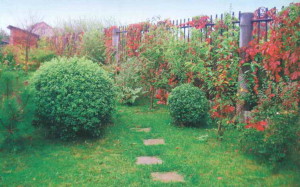
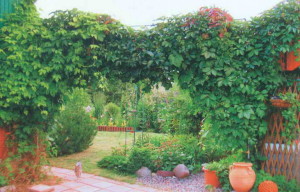
Honeysuckle Compact even without cutting forms a perfect ball, the one on the right is smaller because it sits in the shade, and the weakly decorative pipe of the summer water supply is completely hidden by two vines: yellow-leaved hop and maiden grape

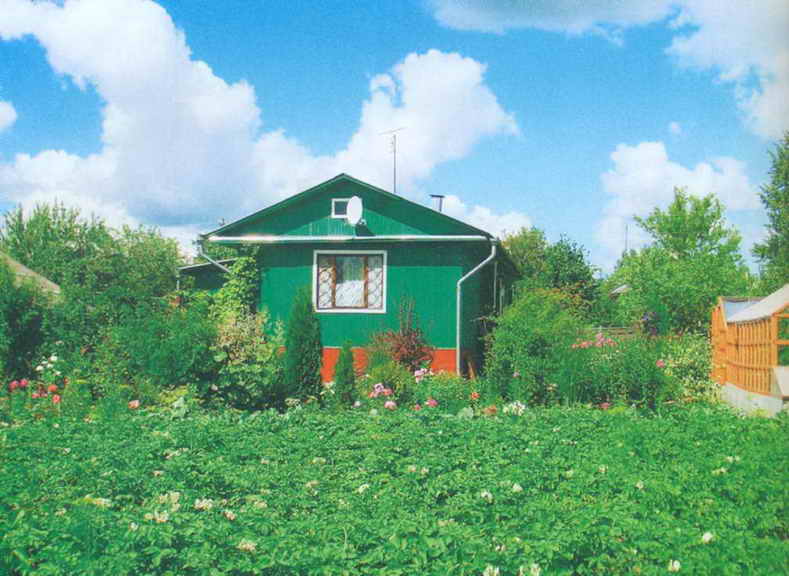
The arch accentuates the transition from the vegetable garden to the decorative part of the garden, and the potato field occupies most of the garden
Vegetable garden planning: option 1
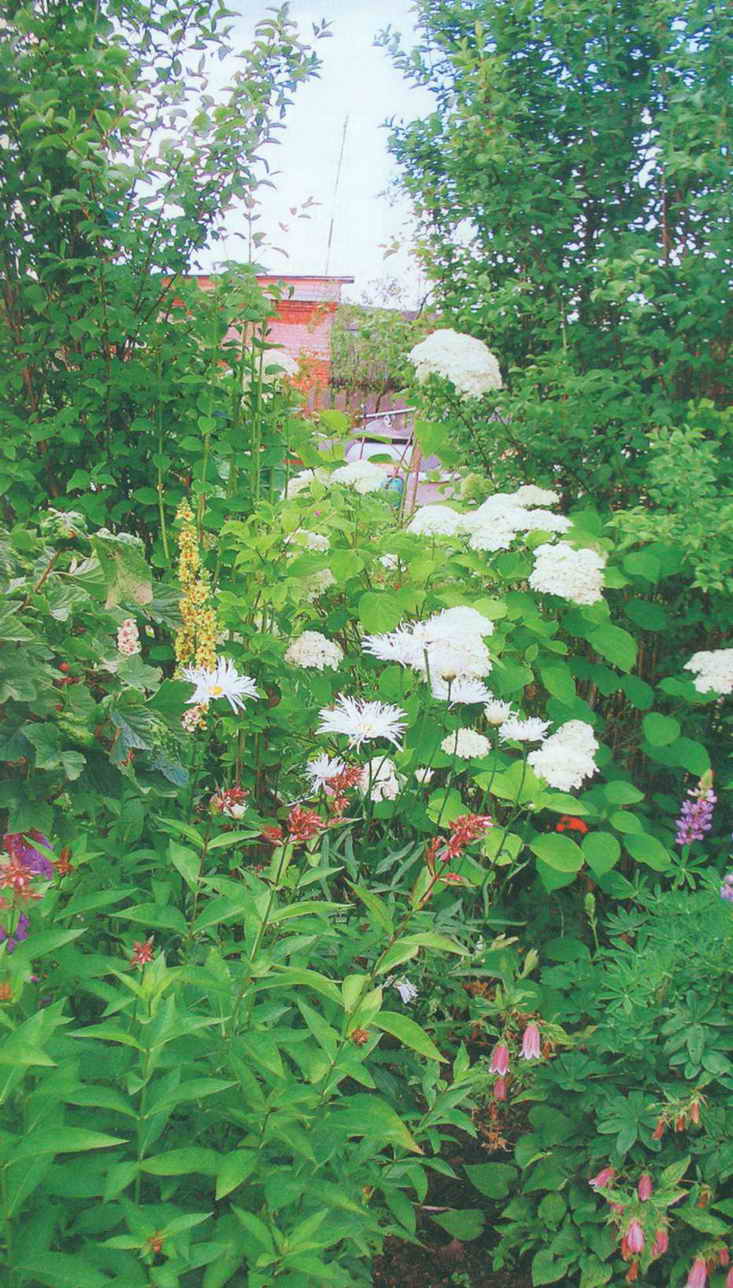 Here is a fragment of a large mixborder, visually blocking the view of the traditional vegetable garden from the house and recreation area.
Here is a fragment of a large mixborder, visually blocking the view of the traditional vegetable garden from the house and recreation area.
Let's take traditional vegetable garden, not decorative, stationary beds, fenced with flat slate, neat and comfortable (length 10 m, width 80 cm), the passage between them is 50 cm. Reserved for growing vegetables sunny place, protected from northern winds. The garden has three sections according to all the rules, and water is available for irrigation.
Favorite vegetables in a traditional garden are cabbage and onions. They are always a great success. Family onions (its botanical name is ) have been grown for a long time; in one nest there are many large onions that are well stored; they taste more delicate than onions. Every year you can collect 15 buckets of this onion, not counting the white and red onions from the Dutch set.
The English proverb is true: “The best of flowers are cabbage flowers.” All kinds of cabbage are grown here: cauliflower, kohlrabi, cabbage, and cabbage of three ripening periods - early, middle, late. And my favorite is the red cabbage one. In autumn, poured red-purple heads of cabbage sit on bluish leaves. Not cabbage - rose!
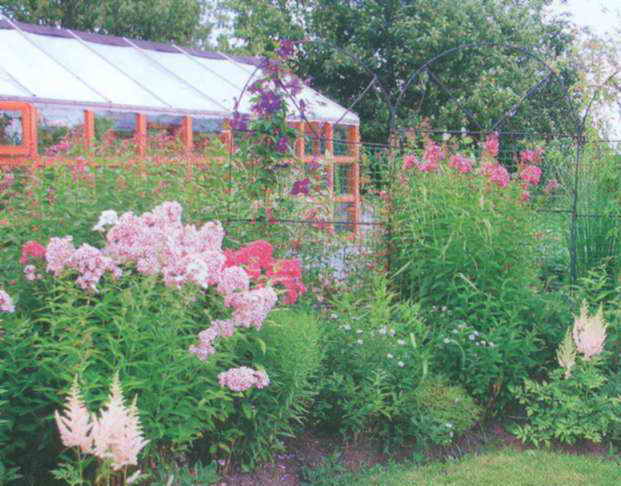 A good, neat greenhouse does not irritate the eye; the garden is hidden behind a mixborder. Timely watering and fertilizing, compliance with crop rotation, loose fertile soil. Every fall, a truckload of manure is purchased and placed in the compost and on the beds. Mineral fertilizer (Kemira-Universal) is also used, but sparingly - expensive.
A good, neat greenhouse does not irritate the eye; the garden is hidden behind a mixborder. Timely watering and fertilizing, compliance with crop rotation, loose fertile soil. Every fall, a truckload of manure is purchased and placed in the compost and on the beds. Mineral fertilizer (Kemira-Universal) is also used, but sparingly - expensive.
If you enjoy growing vegetables and can devote a lot of time to it, then a greenhouse in a traditional garden will bring you a lot of joy. It is convenient to grow seedlings of vegetables and flowers in a greenhouse and preserve heat-loving plants from frost. It can be not only a “closed garden bed”, but also a cozy refuge for fiddling with your favorite plants and even a place for reflection and dreams. But when starting a plant, do not forget that you need to open it in the morning and close it in the evening, and water the plants daily. It should be arranged only if you have the desire and time to care for the plants.
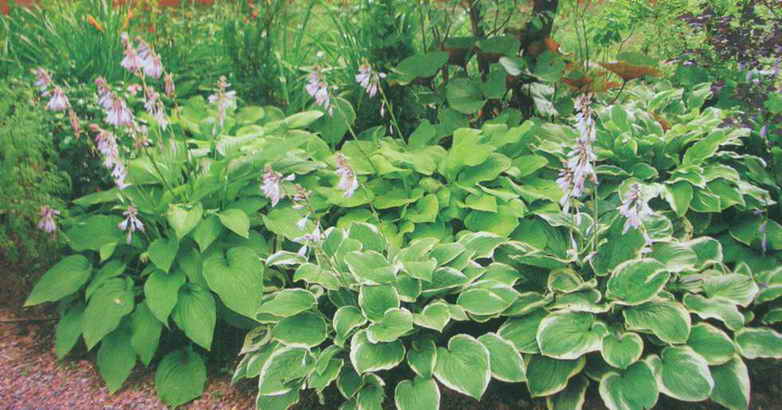 Traditional vegetable garden- this is a separate area that must be closed from the view from the house, from the gate and the recreation area, because for most of the season (spring, early summer and after harvest) it looks unattractive. Here the garden is decorated with a long mixborder, the background of which is occupied by shrubs (turf, columnar thuja, juniper, sumac, weeping rowan on a two-meter trunk, silver oleaster, park roses) and tall perennials (black cohosh, heleniums, etc.). In the foreground are astilbes, daylilies, low perennials, and Siberian irises. This living multi-colored “screen” does its job perfectly. Beauty is beauty, but how to get to the garden? This can be done through the arch, which is an integral part of the mixborder.
Traditional vegetable garden- this is a separate area that must be closed from the view from the house, from the gate and the recreation area, because for most of the season (spring, early summer and after harvest) it looks unattractive. Here the garden is decorated with a long mixborder, the background of which is occupied by shrubs (turf, columnar thuja, juniper, sumac, weeping rowan on a two-meter trunk, silver oleaster, park roses) and tall perennials (black cohosh, heleniums, etc.). In the foreground are astilbes, daylilies, low perennials, and Siberian irises. This living multi-colored “screen” does its job perfectly. Beauty is beauty, but how to get to the garden? This can be done through the arch, which is an integral part of the mixborder.
Often, when thinking about the layout of our garden, we think only about the artistic side of the matter, believing that beauty and benefit are mutually exclusive. As you can see, you can successfully combine both.
 Ornamental plants in the garden
Ornamental plants in the garden
There are also purely decorative elements in the garden, for example, a barberry composition at the entrance to the site. The combination of purple and yellow leaves is solemn and elegant. There are shady mixborders under the old fruit trees, which look impressive against the background of the small lawn adjacent to the path. They are inhabited by decorative foliage plants: hostas, lungworts, ferns, brunners, buzulniki, they are comfortable here.
 To the left of the entrance in the front garden, large shrubs are planted: chokeberry, lilac, mock orange, spirea, which prevent dust and noise from the road from entering the house and the area.
To the left of the entrance in the front garden, large shrubs are planted: chokeberry, lilac, mock orange, spirea, which prevent dust and noise from the road from entering the house and the area.
Between the house and the barn there is a living curtain of grapes and yellow-leaved hops; it always looks good, and in the fall it simply shocks with its beauty. Having passed through it, we find ourselves on the lawn in front of the same mixborder that hides the vegetable garden, and we come to a rectangular pond. Another mixborder is adjacent to the house, the other is adjacent to the garage. Carefully select plants according to their flowering time and plant according to all the rules, creating your favorite mixborders.
 Vegetable garden planning: option 2
Vegetable garden planning: option 2
Decorative vegetable garden, the plan of which is a geometric pattern, is elegant and pleasing to the eye. It requires serious investment to create, but digging in box beds is practically not necessary, the yield in them is always higher, and the vegetables are earlier and more beautiful.
Neat beds look especially decorative if they contain nasturtiums, marigolds, or even short roses, groundcover or miniature, next to vegetables, for example, around the perimeter.
The area of the ornamental vegetable garden and orchard occupies about ten acres, exactly half of the plot, located on two levels. Decorative vegetable garden- lower level, this part of the site goes well with the house.

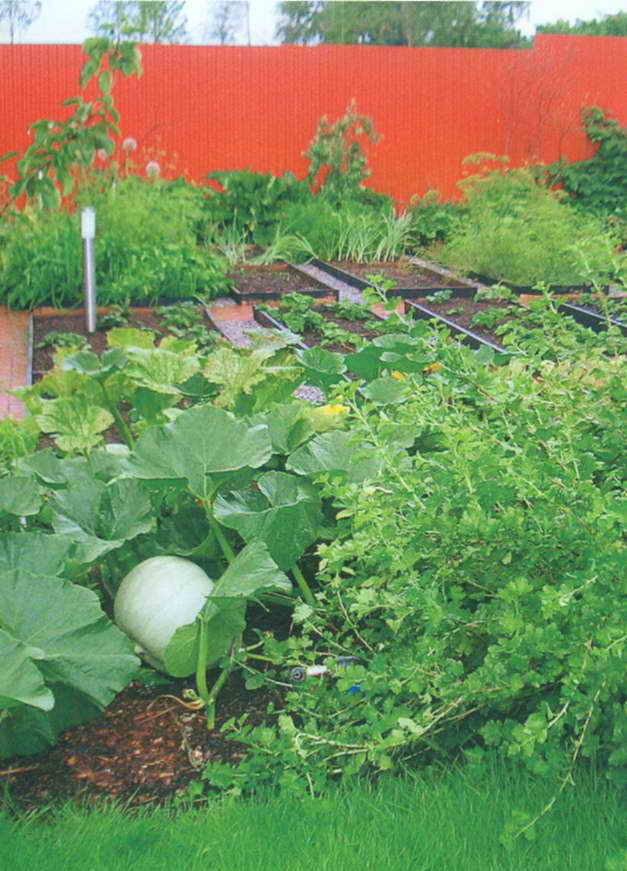
Echinaceas against the background of blue fir trees in the decorative part of the garden and pumpkin are an autumn decoration for a decorative garden; gooseberries are always pretty
The color scheme of graceful wooden arches, pergolas, flower bowls and balustrades, designed in the same style throughout the entire site, is successful.
Not only traditional fruit crops such as apple trees, currants, gooseberries grow in the garden, but also varietal rowan and viburnum, and frost-resistant cherries.
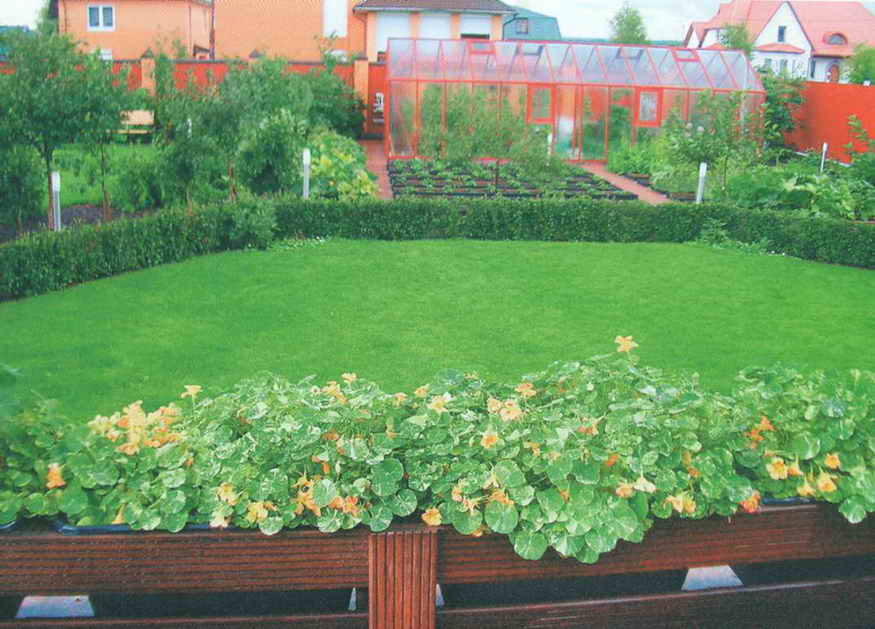 View from the terrace of the house to the ornamental vegetable garden area.
View from the terrace of the house to the ornamental vegetable garden area.
Growing vegetables- one of the most time-consuming tasks in the garden. The garden needs to be cleaned every year, fertilized, sowed, seedlings planted, watered, and weeded. Why fence him off? Firstly, to get the freshest and healthy vegetables. Another reason is savings. You can save some vegetables for the winter and make preparations, although for most working city dwellers this is more of a theory, since you need to be able to grow vegetables, allocate a large area for a garden, spend a lot of free time and a lot of effort on it. The third reason for leaving a vegetable garden is perhaps the most important. Growing vegetables and fruits is a fascinating process that requires skill and talent. Skilled gardeners derive satisfaction from the opportunity to grow the vegetables and variety they want.
 , lined with purple-leaved tenacity, against the background of a purple-pink fence. Dwarf solidago adds color to the fall garden.
, lined with purple-leaved tenacity, against the background of a purple-pink fence. Dwarf solidago adds color to the fall garden.
Now no one can tell us what to plant and in what quantities. Each owner, each family decides this independently. But we should not forget that the Russian garden has always combined beauty and benefit. Even if you have never grown vegetables, try this fun and tasty activity.
Plan for creating a Moorish garden
Landscape design is a matter for professionals
A vegetable garden is not just a plot of land on which you can plant whatever you want, without any rules. Plants, like people, do not always get along with their neighbors in the area, and such features must be taken into account! The layout of your vegetable garden will allow you to avoid a bad “neighborhood” and get the maximum harvest!
If your plot is, in principle, in the shade, then do not despair, even in such conditions you can get a harvest. But you should not sow the seeds directly into the ground, but into seedlings in a warm room. Raised beds will also help your plants get more sun. Don't forget to protect your site from the wind! In this matter, it is important not to overdo it - complete absence air movement, as well as its excess, negatively affects plants.
Be sure to reserve a place on the site medicinal plants and spices. Anise, oregano, hyssop, mint, tarragon (tarragon), elecampane - all these plants are useful not only for human health, they are also good neighbors for fruit crops, since many of the fragrant herbs repel pests.
3 Layout of beds in the vegetable garden - their shapes and heights
Beds that are too wide will be inconvenient to cultivate, while beds that are too narrow will take up much more space in total. Try to find a middle ground in this matter, guided by the size of the plot and the ease of maintaining the beds. It is most convenient to work on rectangular beds, with paths up to 30 cm wide. Be sure to use mulching in areas free from cultivated plants areas - fill paths with sawdust or straw to inhibit the growth of weeds.
If your site has heavy soils, then try creating high beds. To do this, lay out a rectangle 10-15 cm high from boards on the ground and fill it inside with a layer of manure, humus and soil. In high beds, the soil will be much softer and more fertile, so in the spring you will get a much earlier harvest, and if the crops are autumn, it will be much richer.









